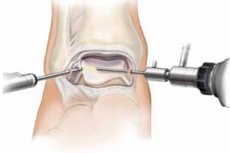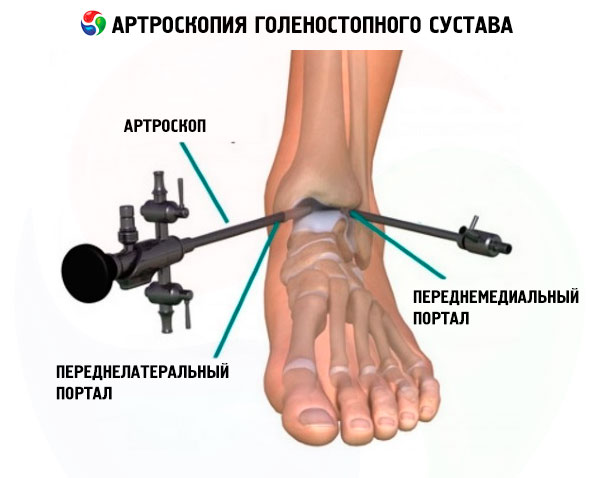Arthroscopy of the ankle
Last reviewed: 23.04.2024

All iLive content is medically reviewed or fact checked to ensure as much factual accuracy as possible.
We have strict sourcing guidelines and only link to reputable media sites, academic research institutions and, whenever possible, medically peer reviewed studies. Note that the numbers in parentheses ([1], [2], etc.) are clickable links to these studies.
If you feel that any of our content is inaccurate, out-of-date, or otherwise questionable, please select it and press Ctrl + Enter.

According to domestic and foreign literature, ankle joint damage accounts for 6 to 21% of musculoskeletal injuries. Despite the large arsenal of funds that modern traumatologists own, the high incidence of unsatisfactory outcomes of treatment of this pathology with conservative treatment is 17%, while operative - 11%.
Damage to bone and soft tissue formations leads to the development of secondary changes in the joint, degenerative-dystrophic processes, structural rearrangement of both damaged and intact ankle tissues , which ultimately leads to its functional insufficiency and contracture.
The radiological picture of bone lesions is well studied. However, a number of intraarticular disorders can not be determined only by means of X-ray methods. These include sprains, ligaments of the articular cartilage with acute trauma, and with chronic trauma, chondromalacia, cysts, intraarticular bodies.
With open intervention, the risk of progression of the joint pathology is aggravated: the onset of the inflammatory process, postoperative instability in the ankle joint, increasing limitation of movements, ankle pain, synovitis, contracture, and sometimes the development of ankylosis. Patients with various ankle joint injuries, as a rule, have walking discomfort, they experience pain during prolonged standing, can not wear regular shoes.
Indications and contraindications for arthroscopy of the ankle
Indications for arthroscopy of the ankle are as follows:
- pain of unclear etiology;
- synovitis, hemarthrosis;
- blockade of the joint (intraarticular bodies);
- transchondral fractures and detachment of cartilage;
- initial phenomena of deforming arthrosis;
- dissecting osteochondritis;
- changes in cartilage with impingement syndrome;
- chondromatosis;
- arthritis;
- fractures of the ankles;
- instability of the joint;
- arthrodesis.
Relative contraindications:
- infection of the skin;
- inflammatory diseases in paraarticular tissues;
- expressed stages of deforming arthrosis;
- complicated somatic state of the patient.
Arthroscopic approaches
With diagnostic and operative arthroscopy of the ankle, three front and two rear accesses are used, which in different combinations are used to introduce an arthroscope and instruments. Front accesses are located along the front joint slot.

Anteromedial (anteromedial) access is located 0.5 cm below the articular fissure, somewhat medial to the tendon of the anterior anterolateral muscle, lateral to the inner ankle, proximal to the medial edge of the talus dome. There is a risk of damage to the terminal branch of n. saphenous and v. saphenous.
Anterolateral (anterior) access serves as the main portal for performing arthroscopy. It is 0.5 cm distal to the articular fissure, somewhat lateral to the V tendon of the finger, medial to the outer ankle, proximal to the lateral part of the talus dome. Possible damage to the external cutaneous branch of the peroneal nerve.
The anterocenter (anteroventral) access is 0.5 cm distal to the joint gap, between the long extensor of the first finger and the tendon of the anterior tibial muscle. There is a risk of damage to the deep peroneal nerve and anterior tibial artery.
Posterolateral (backward) access is the only recommended rear portal. It is located 1 cm below the anterior approach and 0.5 cm distal to the joint space, adjacent to the Achilles tendon. Possible damage v. saphenous and n. surahs.
Posteromedial (posterior) access is 0.5 cm distal to the joint space, somewhat medial to the Achilles tendon edge at this level. Use this access is not recommended because of inefficiency and high risk of damage to the formations of the tarsal canal (posterior tibial nerve and artery).
A fairly complete view of the ankle joint is possible from two anterolateral approaches using an arthroscope with a diameter of 4.5 mm with a viewing angle of 30 °.
Using the above accesses, it is possible to examine 95% of the articular space: articular surfaces of the tibia and talus, both ankles, talon-ankle joints, deltoid ligament, talon-peroneal ligaments, synovial pockets.
Technique of performing arthroscopy of the ankle
The procedure is performed under spinal or conduction anesthesia. The patient's position on the operating table is lying on his back. The operated limb is fixed at the level of the middle third of the shank and fixed on the operating table in a special stand at a height of 20 cm. After treatment of the operation field, arthroscopy of the ankle joint is carried out from two approaches: anteromedial and anterolateral. At the same time, the assistant stretches the articular cleft of the ankle by traction at the foot (manual method of distraction). It is possible to use other methods of distraction: distraction due to cuff traction (use of the load) and with the help of apparatuses and devices (for example, a core distractor). The optimum amount of distraction is 7-8 mm.
First, examine the front, then the back of the joint. After the introduction of an arthroscope into the cavity of the ankle joint, examine the articular surfaces of the tibial and talus bones, both ankles, talon-ankle joints, deltoid ligament, talon-peroneal ligaments, synovial pockets. In the case of initial phenomena of deforming arthrosis, high-frequency ablation is performed, articulation of the joint surface, in the presence of intraarticular bodies, they are removed. With dissecting osteochondritis of the talus, a high-frequency ablation of cartilage of the talus is used.


 [
[